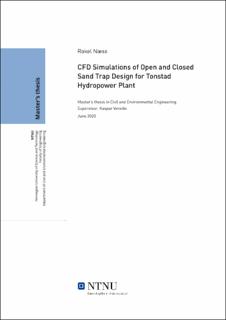| dc.contributor.advisor | Vereide, Kaspar | |
| dc.contributor.advisor | Havrevoll, Ola Haugen | |
| dc.contributor.advisor | Pummer, Elena | |
| dc.contributor.author | Næss, Rakel | |
| dc.date.accessioned | 2021-09-20T16:23:35Z | |
| dc.date.available | 2021-09-20T16:23:35Z | |
| dc.date.issued | 2020 | |
| dc.identifier | no.ntnu:inspera:58605764:24434025 | |
| dc.identifier.uri | https://hdl.handle.net/11250/2779498 | |
| dc.description.abstract | Denne masteroppgaven handler om numerisk modellering (“Computational Fluid Dynamics”, CFD) av Sandfang 3 ved Tonstad kraftverk med dagens utforming og rekonstruert med horisontale ribber. Det ble observert sedimentproblemer i sandfanget etter kapasiteten økte da en femte turbin ble installert. Simuleringene er basert på geometrien for dette sandfanget, og de numeriske simuleringene er gjennomført for å studere effekten av å oppgradere sandfanget ved å installere horisontale ribber.
Det er gitt en innføring i teori om sandfang, sedimenttransport og CFD. Teorikapitlene etterfølges av fremgangsmåten for numerisk modellering med Ansys Fluent, inkludert tillaging av geometrien, generering av grid og oppsett av modellene.
To ulike siutasjoner er simulert for å studere effekten av å installere horisontale ribber i sandfanget. Stasjonære “Reynolds-Averaged Navier-Stokes” (RANS) simuleringer ble kjørt for å sammenlikne vannstrømningen med og uten ribber i sandfanget. Transiente RANS simuleringer ble gjennomført for å analysere effekten av ribbene når sedimenter slippes inn i sandfanget.
Resultatene fra de stasjonære simuleringene viste at hastigheten langs bunnen synker når sandfanget rekonstrueres med horisontale ribber. Dette skal i teorien bedre forholdene for sedimentering og redusere medrivningskraften på avsatte sedimenter. De transiente simuleringene med innslipp av sedimenter bekreftet at redusert hastighet langs bunnen gir bedre forhold for sedimentering. Sandfangets fangsteffektivitet øker når horisontale ribber konstrueres i sandfanget.
Det er vist at Ansys Fluent er egnet som CFD-program for modellering av partikler i et trykksatt sandfang. | |
| dc.description.abstract | In this master thesis, Computational Fluid Dynamics (CFD) was used to simulate Sand trap 3 at Tonstad hydropower plant in the current configuration and reconstructed with horizontal shear plates. The operators of the power plant observed sediment problems when the capacity was increased along with the installation of a fifth turbine. The simulations are based on the geometry of this sand trap, and the numerical simulations are carried out to investigate the effect of upgrading the sand trap by installing horizontal shear plates.
It is given an introduction to sand trap, sediment transport and CFD theory. The theory chapters are followed by the procedure for numerical modelling with Ansys Fluent, including creating the geometry, mesh generation and setting up the models.
Two different cases are simulated to study the effect of installing horizontal shear plates in the sand trap. Steady state Reynolds-Averaged Navier-Stokes (RANS) simulations were run to compare the flow behaviour with and without shear plates installed in the sand trap. Transient RANS simulations were carried out to investigate the effect of the shear plates when particles are injected into the sand trap.
The results of the steady state simulations showed that the velocity decreases close to the bed when the sand trap is reconstructed with horizontal shear plates, allowing particles to settle and reducing the entrainment force on the deposits. The transient simulations with injection of particles confirmed that the reduced velocity close to the bed gives better conditions for particle settling. The trap efficiency increases when horizontal shear plates are installed in the sand trap.
It is shown that Ansys Fluent is a suitable CFD software for the modelling of particles in a pressurized sand trap. | |
| dc.language | | |
| dc.publisher | NTNU | |
| dc.title | CFD Simulations of Open and Closed Sand Trap Design for Tonstad Hydropower Plant | |
| dc.type | Master thesis | |
